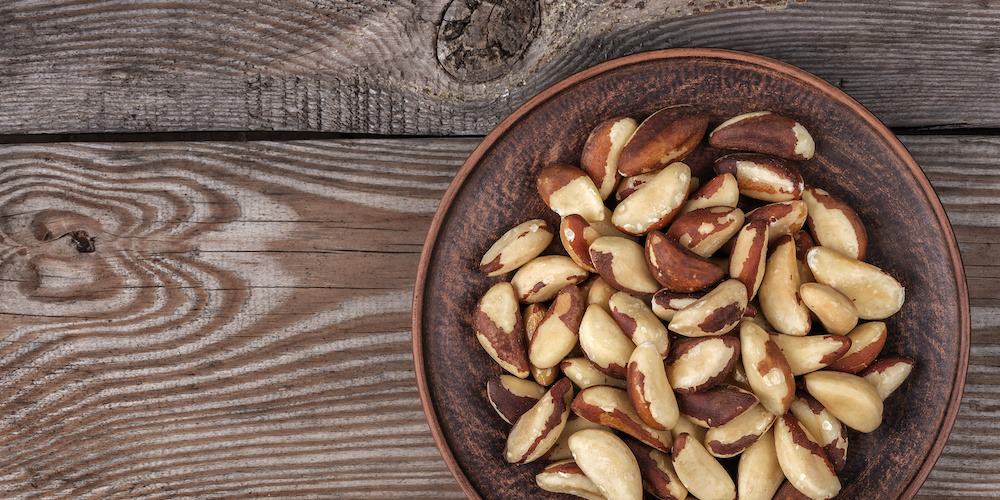BENEFITS OF BRAZIL NUTS
✓ Antioxidant
✓ May help with weight loss
✓ Support cardiovascular health
✓ Improve skin and hair beauty
✓ Potentially anti-cancer
What are Brazil nuts?
The Brazil nut is the fruit of the Amazon nut tree (Bertholletia excelsa). It can reach over 50 m in height and 16 m in circumference, making it a giant of the Amazon rainforest. Like the African baobab (Adansonia digitata), the Amazon nut tree has an exceptional longevity and can live up to 1000 years.
This tree mainly grows in Brazil but also in other tropical regions of South America like Bolivia, Peru, Ecuador, and Colombia. It is generally found in humid environments and along the banks of the Bas-Tocantins and the Rio Madeira in Brazil.
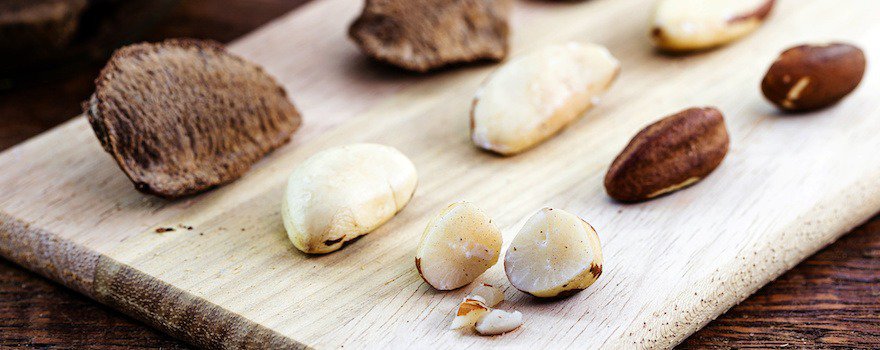
After its flowering, which occurs from August to November, the Amazon nut tree produces large shelled fruits that can weigh up to 1.5 kg.
Each fruit contains numerous elongated seeds, themselves protected by a hard shell. Once the seed is shelled, you find a white almond surrounded by a thin reddish-brown film: the famous Brazil nut.
Commonly known as Brazil nuts or Brazilian chestnuts, they are crescent-shaped. Once dried, they are consumed as is, used in cooking, or packaged for sale. Particularly oily, they are also used to make cooking oil. Brazil nut oil is also used in cosmetics due to its benefits for skin and hair.
Nowadays, Brazil nuts are generally consumed alongside other nuts and oilseeds: almonds, cashews, hazelnuts… They are commonly found in energy mixes of dried fruits and seeds. It must be said that they don’t lack nutritional assets or beneficial properties for the body.
Brazil nuts are particularly recommended for fighting free radicals, stimulating intestinal transit, supporting cardiovascular health, and improving skin beauty. Some studies have also demonstrated their potential in cancer prevention.
Nutritional Composition
- 18 amino acids, including 8 essential ones
- Vitamins: B1, B2, B3, B5, B6, C, E, folates EFA
- Minerals and trace elements: selenium, copper, magnesium, manganese, potassium, calcium, iron, phosphorus, zinc, chlorine, iodine
- Proteins
- Fibres
- Carbohydrates
- Lipids: oleic acid, palmitic acid, stearic acid, α-linolenic acid
- Phenolic compounds: lignans
- Flavonoids
- Phytosterols
- Triterpenes: squalenes
- Water

The benefits of Brazil nuts
🥝 Antioxidant
Brazil nuts stand out for their exceptional selenium content. Although spirulina (Arthrospira platensis), maca (Lepidium Meyenii), and birch sap also contain selenium, their levels are far lower than in Brazil nuts. With 178 µg (micrograms) of selenium per 100 g, one nut is enough to cover our daily needs!
Selenium is a trace element that plays an important role in fighting free radicals and protecting the body. It has a antioxidant effect and actively participates in the production of glutathione peroxidase. This enzyme protects cells against oxidation and regenerates immune cells. Furthermore, glutathione peroxidase supports the activity of antioxidant vitamins such as vitamin C. Hence, a selenium deficiency often results in reduced immunity.
As demonstrated by this analysis of Brazil nut composition, they also contain vitamins, including vitamin E, and amino acids (like methionine and cysteine) that help neutralize free radicals in the body.
This review from the universities of São Paulo and Melbourne explored the nutritional composition of Brazil nuts and their effect on the antioxidant system.
This study from the Federal University of Rio de Janeiro (Brazil), conducted on hypertensive and dyslipidemic patients, shows how the consumption of Brazil nuts increased the antioxidant activity of glutathione peroxidase.
🏃🏼 May Help with Weight Loss
The fiber in Brazil nuts promotes and extends the feeling of fullness. Like chia seeds (Salvia hispanica) and psyllium (Plantago ovata), they are natural appetite suppressants that help control appetite and manage weight. However, they should be consumed in moderation as they are very high in calories (702 kcal per 100 g) and rich in fats.
This study from the Federal University of Goiás (Brazil), conducted on rats, explored the prebiotic properties and potential of nuts, including Brazil nuts, in the prevention and management of overweight and obesity.
❤️ Support Cardiovascular Health
Like most nuts, Brazil nuts contain important nutrients for cardiovascular health. In addition to fiber, they contain heart-beneficial fatty acids such as oleic acid (omega-9), stearic acid, and alpha-linolenic acid (omega-3).
All these fatty acids contribute to the prevention of cardiovascular diseases by maintaining normal blood cholesterol levels. They particularly affect the concentration of LDL cholesterol or “bad cholesterol”.
Finally, Brazil nuts are an interesting source of plant proteins which also help lower the “bad cholesterol” level, responsible for heart diseases.
This study from Pennsylvania State University in the United States, compiling various clinical trials, demonstrates the beneficial effects of nut consumption on the heart and coronary diseases.
👩🦰 Improve Skin and Hair Beauty
Whether consumed or applied as a vegetable oil, Brazil nuts contribute to skin beauty thanks to their high vitamin E content (5.33 mg per 100 g). This vitamin has antioxidant properties that protect the skin from premature aging. Furthermore, it repairs and promotes the maintenance of skin elasticity and firmness.
Brazil nut vegetable oil is softening, soothing, and moisturizing. It is particularly recommended for dry, sensitive, and reactive skin. It can also be directly applied to hair to repair the hair fiber and damaged ends.
This study from the Government Medical College in Srinagar (India), conducted on humans, shows all the benefits of vitamin E for the skin.
🔬 Potentially Anti-Cancer
Studies have highlighted the potential of Brazil nuts in the prevention of certain cancers. Indeed, the selenium they contain, combined with vitamin E, could reduce the risk of breast, colon, lung, and prostate cancer. By stimulating the activity of glutathione peroxidase, selenium protects cells and plays a crucial role in eliminating and detoxifying carcinogens.
This study from the Roswell Park Cancer Institute (United States), conducted on rats, explored the effect of selenium in Brazil nuts in cancer prevention.
♻️ May Stimulate Intestinal Transit
Brazil nuts do not only contain minerals and trace elements; they are also rich in fiber. Thus, 100 g of nuts provide 7.5 g of fiber, more than cashew nuts (4.4 g per 100 g) or walnuts (6.7 g per 100 g).
Fiber is recognized for its benefits on the digestive system and intestines. They relieve discomfort and transit disorders (constipation, bloating…) thanks to their natural laxative effect, facilitate progression in the colon, and balance the intestinal microbiota.
But further studies are needed to evaluate their effectiveness in improving transit.

How to Consume Brazil Nuts?
Dried Brazil nuts
Brazil nuts are most often sold in their dried form. From December, the fruits of the Amazonian nut tree are harvested when they fall to the ground. They are then split open to extract the nuts. These are sun-dried and then sold, shelled or not.
They are easily found online, in organic stores, or in supermarkets offering bulk dried fruits. It is preferable to choose nuts sold with their brown skin (tegument) as they will become rancid less quickly.
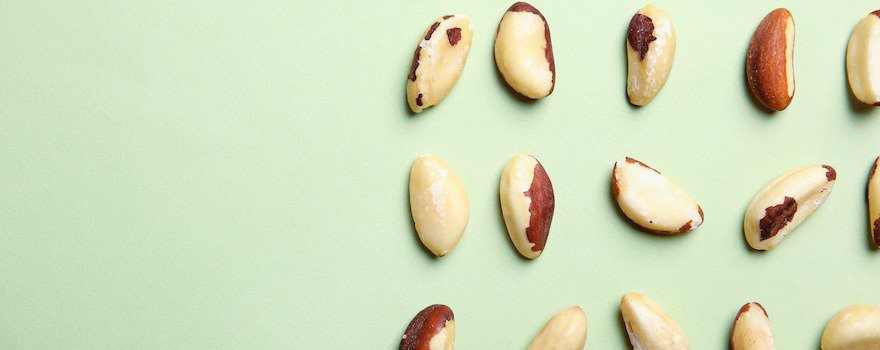
Dried Brazil nuts can be snacked on or used in the preparation of desserts: cakes, cookies, muffins, raw energy bars… You can also make a delicious plant-based drink with Brazil nuts by blending 15 g of nuts with 250 ml of water. Ideal in morning cereals or in pancake batter!
Brazil nut vegetable oil
Brazil nut vegetable oil can be used in cooking. It is used in the same way as regular walnut oil. It is not recommended for cooking, but rather add it to your salads, cold soups, and toasts.
In cosmetics, Brazil nut vegetable oil can easily be integrated into your beauty routine. Add a few drops to your day cream or some shea butter. It can also be applied as a hair mask to nourish and repair damaged hair.
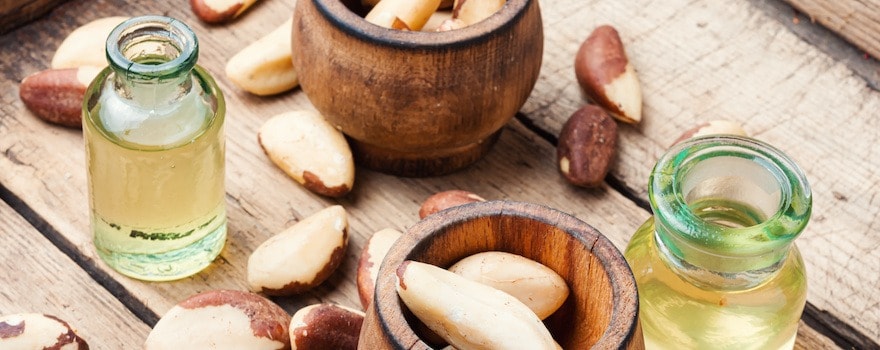
Brazil nuts and berries
Because they are quite caloric, Brazil nuts should not be consumed with other oil seeds that are too high in fat, like macadamia nuts. Instead, pair them with berries or superfoods that are less fatty, like goji berries or açai berries, also native to Brazil.
However, be cautious of selenium excess: intake should not exceed more than 500 micrograms (µg) per day. For reference, 100 g of goji berries provide 60 µg of selenium.
Consume sustainably: choose organic and fair trade Brazil nuts
✓ As usual, it is highly recommended to consume organic Brazil nuts to avoid any pesticide treatments, ensure better product quality, and optimize their benefits. They are often sold in organic stores, so they are easy to find. Organic farming is also more environmentally friendly.
✓ Preferably choose those from fair trade to be sure to support the work of small producers in South America. The harvest and sale of Brazil nuts is a major source of income for many populations in Brazil, Peru, Ecuador, Bolivia, Colombia.
✓ Brazil nut trees are vulnerable species, which is why it is also important to support cooperatives that cultivate them in a respectful manner.
Dosage of Brazil nuts
Rich in calories and selenium, Brazil nuts should be consumed in moderation.
⚖️ It is advised not to eat more than 30 g of nuts per week. Even if they are beneficial for health, limit yourself to snacking on 1 to 2 nuts per day.
Contraindications and side effects
Excess selenium can have harmful effects on health: nausea, fatigue, irritability, hair loss, brittle nails… In addition, the consumption of Brazil nuts presents certain contraindications:
- People allergic to nuts and oil seeds should avoid consuming them
- The consumption of Amazon nuts is not recommended for people with high blood pressure or diabetes;
- People who are overweight or obese should consult their doctor before consuming them.
The excessive consumption of Brazil nuts can lead to the following side effects:
- Digestive disorders (bloating, flatulence…).
- Cramps and stomach aches.
- Allergies.
- Weight gain.
If you experience side effects, stop your consumption and consult a doctor.
History, culture, and market of Brazil nuts
Nuts consumed since forever
Brazil nuts have been consumed for centuries by the populations of South America. According to this review on their use in the Amazon, traces have been found in a cave dating back to the Paleolithic! This means they were already consumed by the ancient hunter-gatherers of the Amazon.
Thanks to the development of trade, Brazil nuts finally reached Europe in the 17th century via Spain and Portugal. Subsequently, the Netherlands, England, and the United States became particularly fond of them.
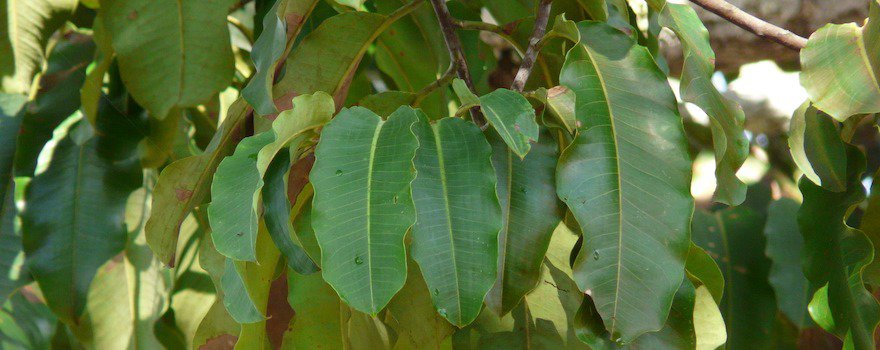
A culture in danger
In South America, the cultivation of Brazil nuts provides a livelihood for many families. For small producers, it is a natural source of food and income. Unfortunately, starting in the 1970s, the intensification of deforestation for livestock, agriculture, and mining endangers this ancient crop.
In the span of a few years, hundreds of hectares of walnut forests are decimated, and Brazilian production collapses, dropping from 104,000 tons in 1970 to 25,000 tons in 2003. Fortunately, in the 1980s, reforestation projects and the reintroduction of the Brazil nut tree helped revive the cultivation.
Today, the Brazil nut tree is still classified among the ‘vulnerable’ species on the IUCN Red List. Programs are being established, and small producers organize themselves into cooperatives and communities.
Report by Julia Perez and Charlotte Jean
Sources and scientific studies
Thavarith Chunhieng, Thierry Goli, Georges Piombo, Daniel Pioch, José Brochier, Didier Montet, 2004. Recent analysis of the composition of Brazil nut Bertholletia excelsa.
Cardoso BR, Duarte GBS, Reis BZ, Cozzolino SMF, 2017. Brazil nuts: Nutritional composition, health benefits and safety aspects.
Huguenin GV, Oliveira GM, Moreira AS, Saint’Pierre TD, Gonçalves RA, Pinheiro-Mulder AR, Teodoro AJ, Luiz RR, Rosa G, 2015. Improvement of antioxidant status after Brazil nut intake in hypertensive and dyslipidemic subjects.
Clara S. A. Sugizaki and Maria Margareth V. Naves, 2018. Potential Prebiotic Properties of Nuts and Edible Seeds and Their Relationship to Obesity.
Mohammad Abid Keen and Iffat Hassan, 2016. Vitamin E in dermatology.
Ip C, Lisk DJ, 1994. Bioactivity of selenium from Brazil nut for cancer prevention and selenoenzyme maintenance.
Anna Greissing, Florent Kohler, François-Michel Le Tourneau and José Reinaldo Alves Picanço, 2008. Iratapuru and the Brazil nut: an experience of sustainability in the Brazilian Amazon.


